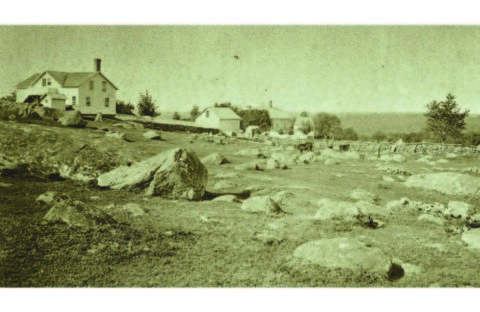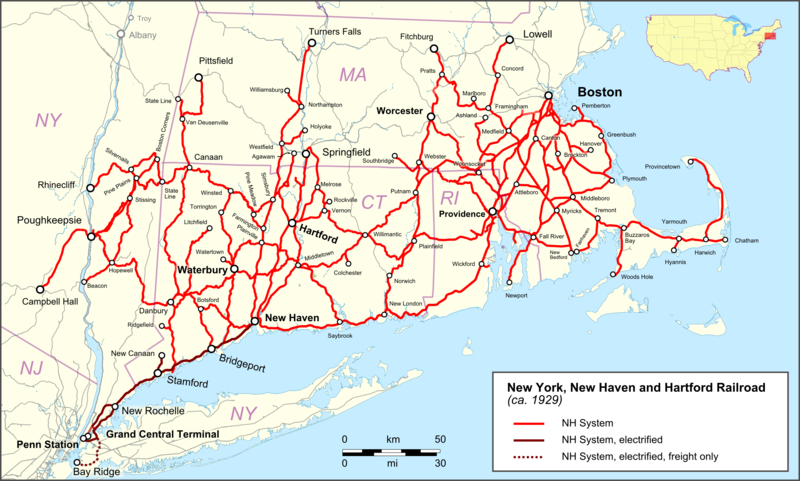Atun-Shei Films
Published 20 Jan 2023Native American living historians Drew Shuptar-Rayvis and Dylan Smith help me explore the military history of King Philip’s War from the indigenous perspective.
(more…)
January 26, 2023
Indigenous Weapons and Tactics of King Philip’s War
January 7, 2022
September 7, 2021
Fallen Flag — the New York, New Haven & Hartford Railroad

Around the beginning of the 20th century, New York investors led by J. P. Morgan gained control, and in 1903 installed Charles S. Mellen as President. Charles Francis Murphy’s New York Contracting and Trucking company was awarded a $6 million contract in 1904 to build rail lines in the Bronx for the New York, New Haven, and Hartford Railroad. An executive at the railroad said the contract was awarded to avoid friction with New York City’s Tammany Hall political machine. In response to this contract, the New York State Legislature amended the city’s charter so that franchise-awarding power was removed from the city council and given to the Board of Estimate and Apportionment, which only recently became defunct in 1989. Morgan and Mellen achieved a complete monopoly of transportation in southern New England, purchasing other railroads and steamship and trolley lines. More than 100 independent railroads eventually became part of the system before and during these years, reaching 2,131 miles at its 1929 peak. Substantial improvements to the system were made during the Mellen years, including electrification between New York and New Haven. […] Morgan and Mellen went further and attempted to acquire or neutralize competition from other railroads in New England, including the New York Central’s Boston and Albany Railroad, the Rutland Railroad, the Maine Central Railroad, and the Boston and Maine Railroad. But the Morgan-Mellen expansion left the company overextended and financially weak.
In 1914, 21 directors and ex-directors of the railroad were indicted for “conspiracy to monopolize interstate commerce by acquiring the control of practically all the transportation facilities of New England.”
J.W. Swanberg carries on the story of the railroad’s woes during and after the First World War:
The New Haven was a financial powerhouse at the start of the 20th century, but from 1903 to 1913, the road was driven to near bankruptcy under President Charles S. Mellen and financier J.P. Morgan. One gain in this period, though, was control of the Central New England Railway, which included the Hudson River bridge at Poughkeepsie, N.Y., and the link to Maybrook and nearby Campbell Hall. This was New Haven’s gateway to the west, also served by trunk lines Erie; New York, Ontario & Western; and bridge lines Lehigh & Hudson River and Lehigh & New England.
World War I government control and the Roaring 1920s boom times saved the New Haven, but not enough to survive the Great Depression, and bankruptcy came in 1935. World War II traffic allowed recovery and rebuilding, but soon all was lost by mismanagement and bankruptcy came again in 1961. The postwar New Haven faced not only highway and airline competition but also the almost total erosion of New England’s heavy industrial base. Just a shell of the once-mighty railroad was forced into a reluctant Penn Central on Jan. 1, 1969.
One of the line’s claim to fame was the early electrification program the New Haven embarked on in 1907:

“View of Typical Sectionalizing Bridge, Auto-Transformer Installation and Cable Runway May 2, 1914.”
Photo and original caption from Electric Railway Journal via Wikimedia Commons.
The New York, New Haven and Hartford Railroad pioneered electrification of main line railroads using high-voltage, alternating current, single-phase overhead catenary. It electrified its mainline between Stamford, Connecticut, and Woodlawn, New York, in 1907, and extended the electrification to New Haven, Connecticut, in 1914. While single-phase AC railroad electrification has become commonplace, the New Haven’s system was unprecedented at the time of construction. The significance of this electrification was recognized in 1982 by its designation as a National Historic Engineering Landmark by the American Society of Mechanical Engineers (ASME).
[…]
The New Haven’s system was extended across the Hell Gate Bridge to the New York Connecting Railroad upon the line’s construction. The system of electrification was an extension of the New Haven’s revised 11/22 kV autotransformer architecture. The original electrification extended from the New Haven’s main line, across the Hell Gate Bridge, to the Bay Ridge yard. The line south of Bowery Bay Junction was de-electrified in the 1950s. The line between New Rochelle and the Harold Interlocking was transferred to Amtrak in 1976 upon dissolution of Penn Central. The electrification system continued to be controlled as a portion of the ex-New Haven system until the 1987 conversion to 60 Hz operation.
When the New Haven main line was converted by Metro-North to 60 Hz operation, the Amtrak Hell Gate line was also converted, but as an isolated system powered from the Van Nest substation. Control of the catenary system was transferred from Cos Cob to the Load Dispatcher at New York Penn Station. Although conversion occurred subsequent to the PRR-era electrification, Amtrak substation numbers 45-47 were assigned for consistency with the rest of the PRR numbering scheme.
October 30, 2020
Halloween Special: H. P. Lovecraft
Overly Sarcastic Productions
Published 31 Oct 2018HAPPY HALLOWEEN IT’S TIME TO GET SPOOKY WITH HISTORY’S MOST PROBLEMATIC HORROR WRITER LET’S GOOOOO
While there’s something to be said for separating the art from the artist, I think there’s a lot of merit in CONTEXTUALIZING the art WITH the artist. Did Lovecraft write some pretty incredible horror? Sure! Was he also a raging xenophobe? Absolutely! Are his perspectives on life connected with the stories he felt compelled to tell? Duh! If you look at Lovecraft’s writing through the lens of his life, clear patterns emerge that allow us to pin down what exactly he built his horror cosmology out of. It’s an invaluable analytical tool that allows us to take apart his writings by getting inside his head. So before you yell at me for Not Separating The Artist From The Art, know that it was completely intentional and I’m not sorry.
3:20 – THE CALL OF CTHULHU
8:40 – COOL AIR
10:36 – THE COLOR OUT OF SPACE
14:38 – THE DUNWICH HORROR
19:32 – THE SHADOW OVER INNSMOUTHPATREON: www.patreon.com/user?u=4664797
MERCH LINKS:
Shirts – https://overlysarcasticproducts.threa…
All the other stuff – http://www.cafepress.com/OverlySarcas…
From the comments:
Overly Sarcastic Productions
1 year ago
Hey gang! Can’t help but notice the comment section is a little bit on fire. That’s all good with me, but one recurring complaint I’ve noticed has started to get under my skin – namely that my explanation of non-euclidean geometry was insufficient, or even – dare I say – inaccurate. Now this is a fair complaint, because after a lifetime of experience finding that people’s eyes glaze over when I talk math at them, I concluded that interrupting a half-hour horror video with a long-winded explanation of a mathematical concept wouldn’t go over too well. I put it in layman’s terms and used a simple example to illustrate the point. However, since some of the more mathematically-inclined of you took offense, I now present in full a short (but comprehensive) explanation of what exactly non-euclidean geometry is.First, we axiomatically establish euclidean geometry. Euclidean geometry has five axioms:
1. We can draw a straight line between any two points.
2. We can infinitely extend a finite straight line.
3. We can draw a circle with any center and radius.
4. All right angles are equal to one another.
5. If two lines intersect with a third line, and the sum of the inner angles of those intersections is less than 180º, then those two lines must intersect if extended far enough.Axiom #5 is known as the PARALLEL POSTULATE. It has many equivalent statements, including the Triangle Postulate (“the sum of the angles in every triangle is 180º”) and Playfair’s Axiom (“given a line and a point not on that line, there exists ONE line parallel to the given line that intersects the given point”).
Euclidean geometry is, broadly, how geometry works on a flat plane.
However, there are geometries where the parallel postulate DOES NOT hold. These geometries are called “non-euclidean geometries”. There are, in fact, an infinite number of these geometries, and because the only defining characteristic is “the parallel postulate does not hold”, they can be all kinds of crazy shapes. (As you can see, my explanation of “this is just how geometry works on a curved surface” is quite reductive, but at the same time serves to get the general impression across without going into too much detail.)
An example of a non-euclidean geometry is “Elliptic geometry”, geometry on n-dimensional ellipses, which includes “Spherical geometry” as a subset. Spherical geometry is, predictably enough, how geometry works on the two-dimensional surface of a three-dimensional sphere.
In spherical geometry, “points” are defined the same as in euclidean geometry, but “line” is redefined to be “the shortest distance between two points over the surface of the sphere”, since there is no such thing as a “straight line” on a curved surface. All “lines” in spherical geometry are segments of “great circles” (which is defined as the set of points that exist at the intersection between the sphere and a plane passing through the center of that sphere).
The axiom that separates spherical geometry from euclidean geometry and replaces the parallel postulate is “5. There are NO parallel lines”. In spherical geometry, every line is a segment of a great circle, and any two great circles intersect at exactly two points. If two lines intersect when extended, they cannot be parallel, and thus there are no parallel lines in spherical geometry.
Since the Parallel Postulate is equivalent to Playfair’s Axiom, the fact that no parallel lines exist in spherical geometry negates Playfair’s Axiom, which thus negates the Parallel Postulate and defines spherical geometry as a non-euclidean geometry. Also, since the Triangle Postulate is another equivalent property to the Parallel Postulate, it is thus negated in spherical geometry. Hence, my use in-video of an example of a triangle drawn on the surface of a sphere whose inner angles sum greater than 180º.
Hope that cleared things up (and helped explain why I didn’t want to say “see, non-euclidean geometry is just a geometry where Euclid’s Parallel Postulate doesn’t hold – hold on, let me get the chalkboard to explain what THAT is-” in the video)
Peace!
-R ✌️
October 7, 2020
The Great Swamp Fight: The Bloodiest Day of King Philip’s War
Atun-Shei Films
Published 6 Oct 2020In December 1675, in the midst of King Philip’s War, an army of Puritan colonists made a preemptive strike against the neutral Narragansett tribe. Their desperate battle in the snowy wilderness of Rhode Island became a touchstone in the cultural lore of Anglo New England, while the subsequent massacre would go down as the darkest, most tragic event in Narragansett history.
Support Atun-Shei Films on Patreon ► https://www.patreon.com/atunsheifilms
Leave a Tip via Paypal ► https://www.paypal.me/atunsheifilms (All donations made here will go toward the production of The Sudbury Devil, our historical feature film)
Buy Merch ► teespring.com/stores/atun-shei-films
#KingPhilipsWar #NewEngland #AmericanHistory
Original Music by Dillon DeRosa ► http://dillonderosa.com/
Reddit ► https://www.reddit.com/r/atunsheifilms
Twitter ► https://twitter.com/atun_shei~REFERENCES~
[1] Eric Schultz and Michael Tougias. King Philip’s War: The History and Legacy of America’s Forgotten Conflict (1999). The Countryman Press, Page 269
[2] Douglas Leach. Flintlock and Tomahawk: New England in King Philip’s War (1958). Parnassus Imprints, Page 58-62
[3] Leach, Page 112-117
[4] Schultz & Tougias, Page 246-247
[5] Schultz & Tougias, Page 247-255
[6] Leach, Page 127-129
[7] Schultz & Tougias, Page 259
[8] Leach, Page 129
[9] Leach, Page 148-149
[10] Joseph Dudley. Second Letter of Joseph Dudley (2001). Bigelow Society http://bigelowsociety.com/rod/battles…
[11] Schultz & Tougias, Page 260-261
[12] Leach, Page 130-131
[13] Benjamin Church. Entertaining Passages Relating to King Philip’s War, Tercentenary Edition (1975). Pequot Press, Page 95-102
[14] Schultz & Tougias, Page 264-265
[15] Leach, Page 131
[16] Church, Page 101
[17] “History – Perseverance.” Narragansett Indian Nation http://narragansettindiannation.org/h…
September 1, 2020
King Philip’s War: The Most Important American War You’ve Never Heard Of
[Update, 29 Dec 2022 – Andy has uploaded a new video to correct some of the errors he made in this presentation.]
Atun-Shei Films
Published 9 Jan 2019A generation after the first Thanksgiving, the sachem of the Wampanoag led a coalition of Native American tribes to battle against the ever-encroaching European colonists of New England.
(more…)
January 3, 2013
Rhode Island’s 38 Studios the new poster child for crony capitalism
The 2012 bankruptcy of Rhode Island-based video-game developer 38 Studios isn’t just a sad tale of a start-up tech company falling victim to the vagaries of a rough economy. It is a completely predictable story of crony capitalism, featuring star-struck legislators and the hubris of a larger-than-life athlete completely unprepared to compete in business.
Former Boston Red Sox pitcher Curt Schilling, an iconic figure in New England after anchoring a historic playoff comeback which ended a legendary 86-year title drought, founded 38 Studios near the end of his baseball career in the hopes of becoming a big shot in the intensely competitive multi-player gaming world.
Since 2006, Schilling invested millions of his own fortune into 38 Studios, and with the self-assured bravado he exhibited as a major league baseball player, set out to find investors to infuse his company with the roughly $50 million needed to complete 38 Studios’ first game. Although Schilling is the kind of local legend who could get a meeting with every venture capitalist in New England, Massachussets VCs passed on 38 Studios. WPRI-TV’s Ted Nesi reported that one such potential investor said “it would have taken a lot of babysitting to do a deal with Schilling because he was inexperienced and the management was inexperienced.”
Enter Gov. Donald Carcieri (R-R.I.), term-limited and searching for a legacy after presiding over one of the worst state economies in the U.S., featuring long spells of double-digit employment and frequent last-place finishes in rankings of business friendliness. In a classic spasm of “do something, anything” government desperation, Carcieri made it his mission to lure 38 Studios from its headquarters in Maynard, Massachusetts to Rhode Island.
Using his bully pulpit as both governor and chairman of the Rhode Island Economic Devlopment Corporation (RIEDC), a quasi-public agency whose mission is to promote business in the state, Carcieri pushed hard for 38 Studios to receive a $75 million taxpayer-guaranteed loan.
Each loan guarantee must be approved by the Rhode Island legislature, and when the votes were cast in 2010, only one lawmaker voted against it. Rep. Bob Watson (R-Greenwich) noted “a lot of red flags” in a “very risky” deal that was “too fast, too loose, and frankly, a scandal waiting to happen.” Watson added “more often than not, politicians are very poor when it comes to making business decisions.”
December 5, 2012
Code used by Roger Williams in the 1600s is finally cracked
I first read about Roger Williams in Murray Rothbard’s Conceived in Liberty, but I didn’t know that Williams had left coded notes that had defied analysis until now:
The obscure book’s margins are virtually filled with clusters of curious foreign characters — a mysterious shorthand used by 17th century religious dissident Roger Williams.
For centuries the scribbles went undeciphered. But a team of Brown University students has finally cracked the code.
Historians call the now-readable writings the most significant addition to Williams scholarship in a generation or more. Williams is Rhode Island’s founder and best known as the first figure to argue for the principle of the separation of church and state that would later be enshrined in the Bill of Rights.
[. . .]
Fisher said the new material is important in part because it’s among Williams’ last work, believed to have been written after 1679 in the last four years of his life.
The new discovery is remarkable on several levels, Widmer said.
“Part of it was the excitement of a mystery being cracked, and part of it was Roger Williams is very famous in Rhode Island — no other state has a founder as tied up with the state’s identity as Rhode Island,” he said. “To have a major new source, a major new document, from Roger Williams is a big deal.”
H/T to Bruce Schneier for the link.








